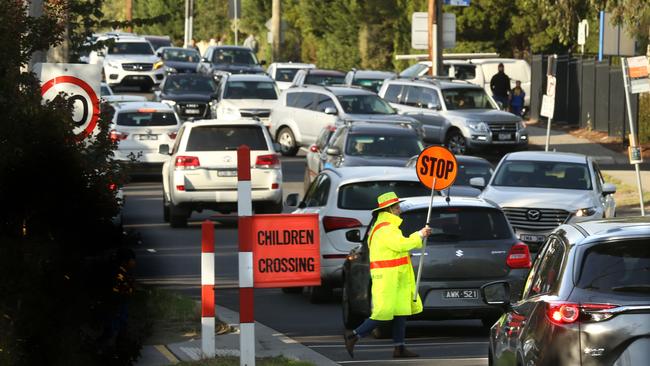More than 1100 Melbourne schools and childcare centres are in a traffic pollution danger zones
More than 1100 Melbourne schools and childcares are linked to locations with higher risks of asthma, illness and other health issues. See the full list.

Victoria
Don't miss out on the headlines from Victoria. Followed categories will be added to My News.
More than 1100 Melbourne schools and childcares are in a traffic pollution danger zone, leaving kids at higher risk of asthma, respiratory illness and other health issues.
A new report has revealed the rate of exposed Melbourne schools was higher than any other Australian capital and warned even small levels of air pollution harmed our health.
The report, released by the Climate Council on Thursday, found almost one-in-four Melbourne schools and childcare centres were within 100m of a busy road which is “close enough” to “raise health risks for the children who attend”.
The report analysed children’s proximity to a major road as multiple studies have found kids “living, learning and playing near major roads are more likely to have asthma, wheeze and poorer lung function”.
“There are multiple sources of air pollution, but there is clear evidence that air pollution from fossil fuel powered vehicles is harming our children,” it said.
“Children are more vulnerable to the harms of air pollution due to their physiology, size and behaviour.”
The report, which analysed every school and childcare’s location in Melbourne, found Boroondara had the highest concentration of at-risk campuses and centres with one in two located near a major road.
Whitehorse West and Port Phillip were the next biggest “danger zones” and recorded the second (47.5) and third (42.2) highest percentage of schools and childcare facilities within a 100m risk zone.
A road was considered a “major road” if it was classified as a freeway, highway or “major connecting road” on popular mapping platform OpenStreetMap.

But the report said their analysis did not account for the type of vehicles, such as trucks, on the roads and Maribyrnong children — despite having a lower proportion of schools near a major route — likely still had poorer health outcomes.
The local area “hosts busy arterial roads used by trucks transporting freight from the nearby Port of Melbourne”, it said.
“Young people aged 3 to 19 residing in the City of Maribyrnong have reported higher rates of hospital admissions for asthma and respiratory conditions compared to the rest of the state,” the report found.
Climate Councillor and public health doctor Dr Kate Charlesworth said air pollution could be as bad for children as “suck in second hand cigarette smoke”.
“As a mum and as a doctor, I want to see fewer and fewer people showing up unwell in our health system because of air pollution,” she said.
Climate Council chief executive Amanda McKenzie said “accelerating renewables and phasing out polluting cars and fossil fuels” was “crucial” to cutting air and climate pollution.
“Our kids deserve to breathe clean air, and we can pass on a safer and healthier future,” she said.
“Let’s give more people in our cities better travel options.
“So it’s easier for more people to use shared and active means of getting around our cities – like walking, riding a bike, or taking public transport – more often.”
Originally published as More than 1100 Melbourne schools and childcare centres are in a traffic pollution danger zones



